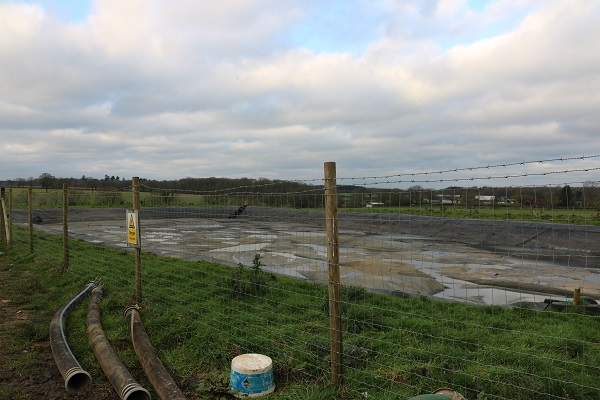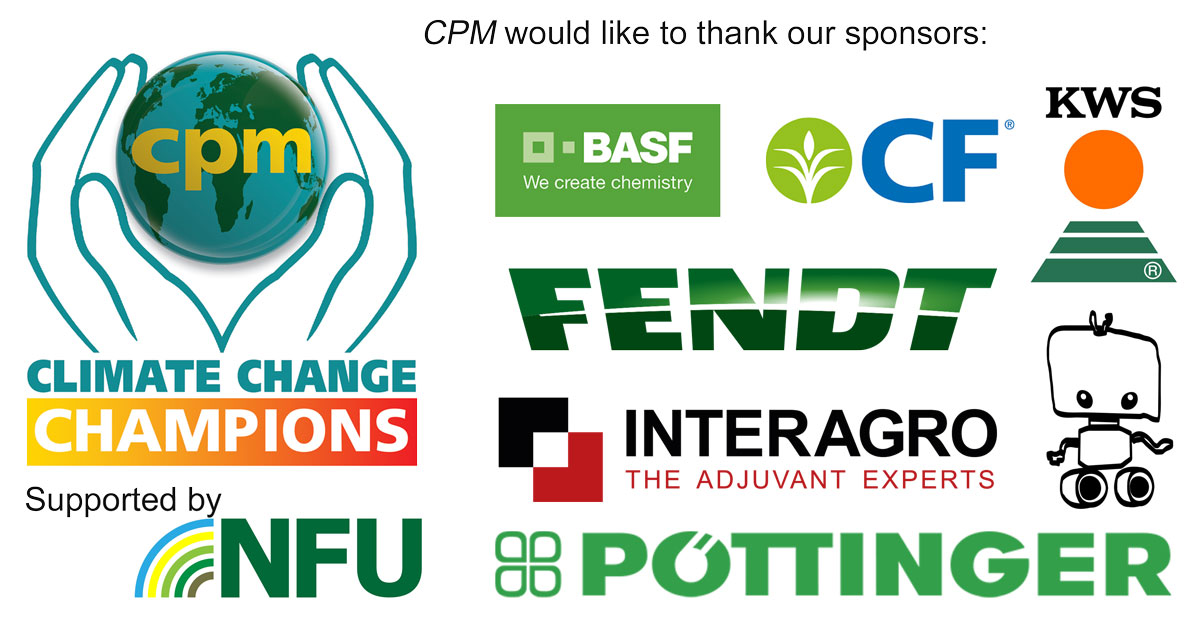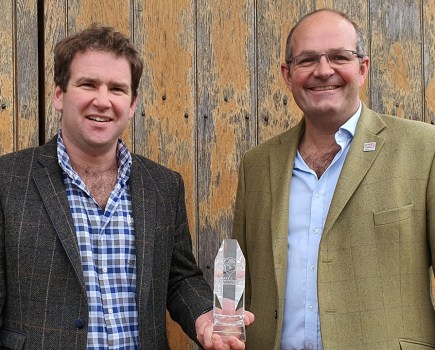Arable operations across a mixed farm in Bucks have been brought perfectly in tune with its dairy and sheep, bringing massive carbon savings. In the first of a brand-new series, CPM finds out what makes the pioneer behind this system a Climate Change Champion.
Everything’s kept on the farm – one thing’s always benefiting something else.
By Tom Allen-Stevens
When you arrive at FH Pullin and Sons, near Silverstone, Bucks, your first impression may well be that it’s a busy, but somewhat haphazard farm. There seems to be a never-ending hive of activity among the scatter of containers and the buildings around which they cluster, which themselves look as though they’re in constantly evolving construction mode.
But as you move from the quietly contented herd of dairy cows sauntering in and out of robot milking machines, past some the farm’s slurry lagoons to the zero-tilled crops in the surrounding farmland, what emerges is the very neat, forward-looking system they support.

One of the farm’s seven slurry lagoons, used to feed all the arable crops and grassland, keeping fertiliser applications to a minimum.
“When it comes to carbon footprint, waste management and productivity, it’s all interlinked into a whole-farm approach,” says Clive Pullin, managing director of the family-owned business that farms 620ha of “clay, clay and more clay” soil, mainly in one ring-fenced block. “It’s a continuation of a family ethic that everything’s kept on the farm – one thing’s always benefiting something else.”
For the arable enterprise, this results in yields averaging 8.25t/ha across his cereals (200ha of winter wheat, mainly milling varieties, 50ha winter barley and 10ha of spring oats). These receive very low herbicide and fungicide inputs and just a single top dressing of bagged fertiliser, while the 4m Krause direct drill usually makes the only cultivation pass. Nearly everything else for the arable crops, which include 40ha of oilseed rape and 65ha of maize, is supplied by the 285-head dairy herd, its 184 followers and the 790-ewe flock of sheep.
But it works both ways, with the arable enterprise an integral part of the dairy. “Our big money-maker is that we produce our silage at a total cost of just £23-28/t. We can’t grow good protein crops here, and don’t like to buy in any soya. So the herd’s protein requirement comes mainly from the 120ha of temporary grass, and that’s where we’ve made the difference,” says Clive.
The average protein content of grass silage is around 13%, but Clive maintains a level closer to 17% for the herd that’s housed all year round. This peaks at 22% when swards are fed fresh-cut. A small amount of rapemeal, dished out of a barrel using a small plastic bucket, is the only bought-in supplement, added to a home-grown and milled mix of barley, wheat and oats, alongside maize silage which completes the ration.
“My wife and I closely monitor the milk analyses to ensure all the protein is utilised. Yield-wise we get on average 9000 litres/cow over six lactations. This isn’t top-performing, but we’re not pushing our herd to produce the highest yield, aiming for its optimum,” he says.
“Using rapemeal and home-grown cereals instead of soya puts a cap on yield, but rather than buy in a commodity from a questionable source, I prefer we focus on doing a better job of producing high value grass – a crop we can control. What’s more, it doesn’t sit right to destroy the planet just to eke an extra 1000 litres from our cows.”
It’s this same philosophy of optimising output from a sensible use of resources available to him that Clive rolls out across his farming system. So what are the key aspects? Firstly, there’s the grass itself and the high protein content that displaces the need for bought-in supplements. “We use a 30% clover to ryegrass mix and cross-drill leys with a 5% herbage mix specifically designed to boost the natural mineral value,” Clive reveals.
Another aspect is just-in-time cutting and carting, whether this is fed fresh or ensiled, to ensure the protein value is retained. This comes down to the fleet of Fendt tractors in the business. A 936 and an 828 provide the grunt of the mainline tractors, pushing out 366hp and 287hp respectively. They’re used in reverse formation – the seat and controls swivelled through 180° – to drive the farm’s two Kemper forage harvesters.
They’re also put on the two Massey Ferguson 187 balers that each push out 6000 bales/yr – every crop, even OSR, is baled as bedding for the dairy herd, along with some hay, with the straw returned as manure the following year.
Three Fendt 516s, rated at 163hp, perform much of the rest of the farm’s tasks, including most of the arable work. “We do very little ploughing – just for the lazy-rooting maize – and the drill has a very low power requirement. So what we need from the mainline tractors is machines that are tip-top, reliable and efficient across the 1160hrs/yr they work. We can’t afford to have men hanging around waiting for a tractor to be fixed, and the grass has to be cut at peak protein content.”
The tractors are on a service contract with Fendt, traded out after five years. “The fuel saving over other brands pays for the service contract and half the finance charge. But the main difference is that they hold their value – the depreciation works out at £7.69/hr over the five years,” notes Clive.
Only the Fendt tractors operate on this system, with a completely different policy for the plethora of other machinery dotted about the business. There are eight Caterpillar telehandlers, for example, keeping materials moving around each unit of the busy farm. “We buy them relatively cheap at 3000hrs and they last forever. The important thing is that there should always be a telehandler nearby for the job at hand.”
Efficiency in the field is maintained through Fendt’s Tractor Management System (TMS) he adds. “The tractor adjusts its engine speed to the optimum, so when you’re going downhill it’ll drop the tractor revs, saving fuel, but then pick them up again when necessary.”
This is invaluable to ensure peak efficiency when making the many applications of slurry and muck, for example, which form the backbone of the nutrition programme. The farm’s invested in several slurry lagoons, taking in not only home-produced but also imported, nutrient-rich waste water from nearby food plants, as well as anaerobic digestate. These are applied throughout the spring, pumped through an umbilical system to a 14m Vogelsang dribble bar spreader. Every field is regularly nutrient-mapped by SOYL and applications are tailored to requirement.
“Each operator knows what we’re aiming for and sets the forward speed accordingly, following the map which is displayed in the cab. They slow down if the map colour indicates a low index and speed up in the green areas. It involves quite a bit of operator input and I’m looking around for a system that manages variable applications automatically. But we’re already getting good results – the maps from 15 years ago were a rainbow of colours for soil indices, but now they’re more uniform, as are crop yields.”
The system represents a massive saving in bagged fertiliser use, with organic sources supplying 75-90% of crop nutrient requirements, and a resulting huge carbon equivalent saving. There are benefits, too, for soil biology, helped by the zero-till system that’s been developed over 16 years. “I always carry a spade with me and make regular inspections, and we’ve seen steady improvements,” reports Clive.
“The most noticeable aspect is how well the land travels, which is important for us. We also always aim to keep a green cover for as much of the year as possible.”
This is where the sheep come in. Firstly, they come onto the stubble, soon after harvest, to clear chaff and effectively provide a light, scratch cultivation to encourage volunteer and weed seed to chit. The strategy then is to establish a crop with a healthy root, whether cereals or OSR, and graze off the top growth until the early spring. This reduces weed and disease pressure, leaving precious little chemistry for the Rogator 28m sprayer to apply.
“We can get away with just an application of glyphosate pre-drilling and a single fungicide spray,” notes Clive. “The sheep themselves rarely need a top-up feed and are moved regularly onto fresh ground, keeping lameness to a minimum.”
At harvest, the same, just-in-time focus and larger than needed MF 9280 combine with a 9m header have meant no grain has gone through the drier in 13 years.
Clive points out the system he has is not all savings and benefits – the combination of maize in the rotation, direct drilling and quality wheats puts the crop at high risk of fusarium. “We have to spend a lot on testing, although safe limits on toxins have never been exceeded.
“Regulations for the slurry and imported waste we apply are hellish, but I find it easier to do that paperwork than write big cheques for fertiliser.”
But he’s clear on the big wins. “Moving to zero tillage has been a massive benefit for so many reasons. My request to plant breeders is that we need a maize that’s not lazy-rooting so that we can direct drill that crop too. Getting rid of old machines with the mainline tractors also makes sense. Not only are they way more fuel efficient but they ensure timely, effective operations and are extremely comfortable for the operator, which means happy staff. For us, these are the differences that ensure all the farm enterprises work in harmony.”
What makes Clive Pullin a Climate Change Champion?
Innovative ideas
All enterprises across the farm are fully integrated, with waste from the dairy feeding arable crops, which in turn provide nearly all the feed for the dairy, resulting in minimum need for bought-in resources and a greatly reduced carbon footprint.
Productivity push
There’s been a determined focus to maximise protein content of grass silage through timely, efficient operations and careful management, optimising herd performance without the need for any bought-in soya. Well managed grazing of arable crops by sheep has maintained productivity with greatly reduced reliance on agrochemicals.
Cultivation care
All crops, apart from maize are established with zero till, with green cover maximised and a focus on well rooted crops, fixing carbon in the soil. Use of organic manures has increased soil biology, further enhancing its ability to sequester carbon. Hundreds of trees have also been planted in non-productive areas.
Bio-based boldness
Waste from food factories and digestate is stored on farm and used to feed arable crops, displacing the need for nitrate fertiliser. A 250KVA roof-mounted solar array powers the dairy. Rainwater is harvested to cool milk and pre-heat water used in the milking parlour, cutting bills from £10,000/yr to £2000/yr.
Tractor tech helps with efficiency targets
If farmers and their suppliers really want to achieve Net Zero by 2040, then this should be top of mind every time they reach for the tractor keys, believes Martin Hamer, UK and Ireland manager for Fendt.
“It might sound strange coming from a major tractor manufacturer, but Fendt actually wants its customers to use their tractors less,” he says. “Ask yourself: Is this operation really necessary? Could you make a different choice?”
Martin’s a keen advocate of honest appraisals of individual farm enterprise and field profitability, costings of the tools used and desired environmental outcomes. “These steps should lead farmers to make decisions based on the sound evidence of environmental benefit and financial return.”
Fendt offers its customers a package of features and services which allow these costs to be accurately calculated, rather that guesstimated or gleaned from farm management books, he points out.
“By spreading these over a longer period, the big costs such as deprecation can be minimised. Add to this the eight-year full manufacturer’s warranty, fixed cost servicing contracts and very flexible financing solutions and a true cost can be factored into management decision making – it’s a step Clive’s clearly taken,” adds Martin.
“As Clive also points out, when the operator comfort, fuel economy, efficiency gains from the superior Vario transmission and TMS control (standard on Fendt tractors) and a comprehensive technology offering are factored in, even greater definable savings are achievable.”
Fendt tractors are produced in one of the worlds most advanced tractor manufacturing facilities where environmental emissions are under close scrutiny. When necessary, the plant is heated by a combination of re-cycled heat from the machine tools and topped up by energy from a wood chip burning plant.
Climate Change Champions
UK Farming has set itself the challenging target of Net Zero emissions by 2040. Although led by the NFU, it will take the entire industry, working together in a partnership approach to meet this ambitious goal.
But there are individual growers, thought leaders who have already started on this journey. They have the ideas, the progressive outlook and the determination to shape positive change. CPM has teamed up with leading agricultural suppliers who have a credible Net Zero aspiration to identify these individuals and bring them into the top-level discussion about how farming can position itself as the solution to climate change. CPM readers will get the chance later this year to decide who will be awarded the accolade of Climate Change Champion 2020.





